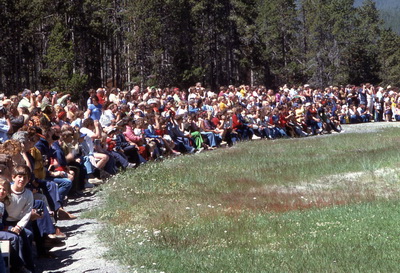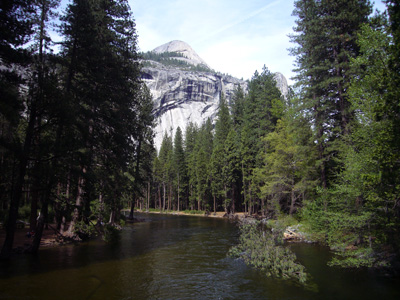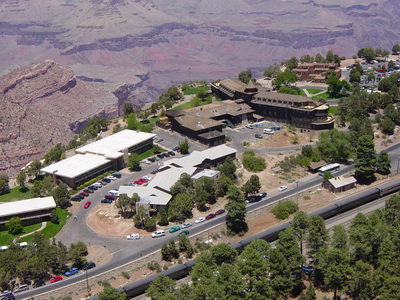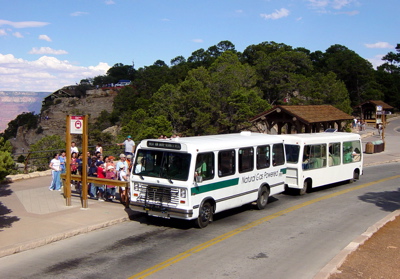
Large numbers of visitors place parks at risk
There is a delicate balance between the visitors and Mother Nature in America’s national parks and right now the visitors are throwing off the balance in their favor.
All of the 275 million annual visitors attending the nearly 400 parks and other units in the National Park Service system look forward to catching all the amazing sights, experiencing history and culture and seeing other attractions.
Rightfully so, but at the same time they do not realize how much of an impact that the herds of humans and their automobiles, recreational vehicles and buses have on those precious parks as well as how much time and preparation goes into making sure their vacations run smoothly with no lines to inhibit them from fully enjoying nature.
| At right, visitors gather around Yellowstone National Park’s Old Faithful to watch the geyser. (Photo courtesy of the National Park Service). |  |
“Visitors cause so much detriment to the landscape. When you have so many people, they are going to cause damage,” said Kari Cobb, a Yosemite National Park ranger and spokesperson.
The main issues facing Yosemite National Park, located in Northern California’s Sierra Nevada mountain range, center on its continuous efforts to implement a plan to preserve the Merced Wild and Scenic River.
Yosemite officials first created a plan to combat the crowds surrounding the Merced River, but Congress felt that it did not accomplish enough to preserve the river. Yosemite made a second plan that was also rejected and now park leaders are working on a third plan they hope will be their last.
“We are currently trying to come up management policies that will help with the restoration of the river. We have the total number of visitors that visit the river, but right now we are exploring how many visitors certain areas of the park can handle,” said Cobb.
Yosemite’s problems with crowds and crowd control do not stop with the Merced River. Crowds used to cause damage to the vegetation in the meadows of Yosemite Valley until boardwalks were installed to prevent more harm to the plants.
“We don’t have any rules forcing the visitors to cross the boardwalk, but with them installed, the visitors say ‘Hey. There’s a boardwalk, so I’m going to conveniently walk over that instead of the meadow,’” elaborated Cobb.
 |
The Merced River flows through scenic Yosemite Valley at Yosemite National Park (Photo by Bruce Garrison). Below, the South Rim Village at Grand Canyon National Park. Last, the South Rim shuttle bus at the Grand Canyon (Photos courtesy of the National Park Service). |
While Yosemite continues to battle the ever-growing crowds, other popular parks around the nation have begun to have issues with traffic flow, parking and how to prevent these problems in the future.
“Last year alone, we had over one million vehicles enter the park. We could see up to 5,000 vehicles per day on some of the more popular days. With only 1,200 parking spots, we were bound to have problems,” said Maureen Oltrogge, public affairs officer for the Grand Canyon National Park.
“The excess cars would park on the sides of the roads causing damage to the vegetation and other resources there,” continued Oltrogge.
So, in order to stop more traffic problems, the Grand Canyon provided 600 new parking spots beginning on Nov. 23, with a possibility of opening up 300 new spots if needed.
“We originally were going to create a light rail system, but congress told us to look into bus alternatives. So, now we have the new 600 parking spots along with a shuttle system to bring in the 400 parking spots outside the park as well as the adjacent city, Tusayan, and other various routes,” said Oltrogge.
 Olympic National Park, in Washington State, has similar problems as the Grand Canyon; however, its problems generally revolve around the brutally cold winters.
Olympic National Park, in Washington State, has similar problems as the Grand Canyon; however, its problems generally revolve around the brutally cold winters.
“Hurricane Ridge, one of the most popular areas of the park, with its high elevation, is the easiest way to be in the mountains. In the winter, the snow shrinks the parking lot causing them to fill up quickly, making the road closed to any uphill traffic. This obviously causes problems for us,” said Barbara Maynes, public information officer for Olympic National Park.
Within the next month, there will be a meeting to discuss an alternative transportation plan. The park is looking into applying a shuttle system much like the Grand Canyon’s, or a system of private cars to bring the visitors to Hurricane Ridge.
“Not only will it be convenient to fix these parking problems, but it will also provide us with other benefits, like fewer carbon emissions,” continued Maynes.
While all of these parks are experiencing traffic and crowd problems, Yellowstone National Park sees no real reason to change its ways, even with its 2,870,295 visitors.
“Up to 1,500 people will be around the Old Faithful geyser during an eruption, then they all leave at once, some to lodging, parking, walking the basin, or looking for food service. There is really no need to specifically manage these crowds,” said Tammy Wert, Yellowstone National Park fee program manager.
While traffic can cause difficulties for other parks, it is not too much of a problem when it comes to Yellowstone. Generally, they use traffic as a chance for a new attraction.
 “On the road system, any time there is an animal near the road, it may create a traffic jam. Protocol for clearing traffic includes allowing visitors to view from a safe distance, park off the roadway and move traffic through the area,” continued Wert.
“On the road system, any time there is an animal near the road, it may create a traffic jam. Protocol for clearing traffic includes allowing visitors to view from a safe distance, park off the roadway and move traffic through the area,” continued Wert.
While Yellowstone is staying pat, it seems that all of the largest and most popular western parks have plans to help ease the lines and traffic that stress out nearly all of the visitors. Not only that, but underneath all of the renovations is the preservation of the beautiful national parks.
“Yes, we are helping to make the experience better as a whole for the visitor, but we’re really preventing future destruction of these lands,” said Cobb.

Comments are Closed